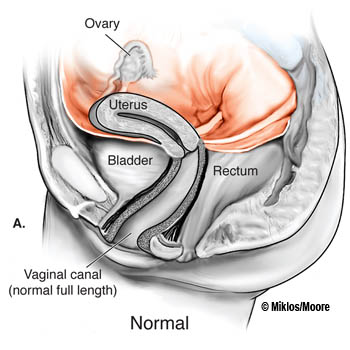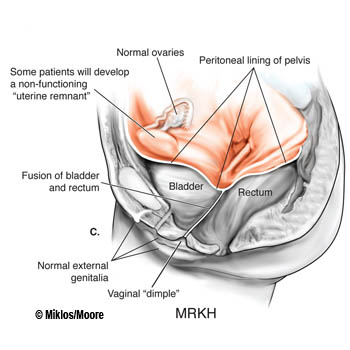MRKH
Vaginal agenesis is a congenital disorder of the reproductive system in females that affects approximately 1 in 5,000 females. In this disorder, the uterus and the vaginal canal do not develop properly during the pregnancy and the female is born with a very short vaginal canal or no vagina at all (in most cases there is a “dimple” present between the labia where the vaginal opening should be). The condition is typically not detected until puberty when the teenage female is delayed in getting her menses or it may be discovered with first attempts at having sex.
Most patients with this abnormality have Mayer-Rokitansky-Kuster-Hauser syndrome (MRKH). In this syndrome the vagina is absent (or very short) and the uterus is absent or extremely rudimentary (i.e. if it is present it is non-functioning and a very small remnant). The ovarian function is normal, the endocrine function is normal, the chromosomes are a normal 46 XX female and the secondary sexual characteristics are normal and that of a female. The patients is a normal female (i.e. appears female with normal breast development and the outside of the vagina appears normal as well), however she just does not have a vaginal canal, nor a functioning uterus at the top of the vagina. The cause of the syndrome remains unclear, however a multifactorial mode of inheritance, including genetic and environmental factors, seems to be the most likely explanation.
Figure A shows normal female development with normal uterus and full length vagina. Figure B demonstrates a patient with MRKH in the fact that the uterus does not fully develop nor does the vagina canal. There is a very short vaginal opening and sometimes just a "dimple" and beyond that the bladder and the rectum are fused together with no intervening vaginal canal.
Figure C demonstrates a patient with MRKH and the fact that there is no uterus and no vaginal canal where it typically should develop between the bladder and the rectum.







